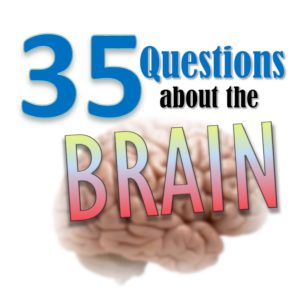 Your head is filled with neurons, blood vessels, support cells (called glial cells) and a couple of glands. That’s pretty much all there is. Here’s a quick tour.
Your head is filled with neurons, blood vessels, support cells (called glial cells) and a couple of glands. That’s pretty much all there is. Here’s a quick tour.
Nuclei
Some neurons form clumps called nuclei. They process information and pass it on. The lateral geniculate nucleus (LGN) processes vision. The medial geniculate nucleus (MGN) processes sound. The amygdalae are nuclei that process emotional information.
There two large neuron formations that are too large to call nuclei: the cerebrum and the cerebellum. This is where most of the neurons hang out.
Cerebrum
The cerebrum is that 3-pound structure that people call the brain. It is a very thin structure; about the size of a large pizza and about as thin as a plastic sack. This of it as a really large computer chip that is folded and refolded multiple times.
The cerebrum has four large sections called lobes. One is devoted to vision (occipital) but the other three have multiple responsibilities.
One deals with touch, temperature, pain, and location information. This parietal lobe (named for the bone it is under) also houses an integrated 3-D view of the world.
The temporal lobe (side of the head) processes sound, faces, object recognition, language, and memory. It holds you encyclopedia of information.
The frontal lobe (in front of all the other lobes) is the largest section, the easiest to damage, and the most complicated. It receives information from all the other lobes, plans and makes movements, and does all your thinking.
Cerebellum
The cerebellum is smaller than the cerebrum but has more neurons (they just happen to be really small). It coordinates both sides of the body and provides your sense of balance. When the police give a sobriety test, they are checking to see if the cerebellum is working properly.
Under the cerebrum, and in front of the cerebellum, there are many smaller structures which work togther as a single unit. This basal ganglia (basement neurons) does a lot of the behind the scenes thinking you’re not aware of. If you’re not thinking about riding your bike or driving your car, the basal ganglia are running the show.
The Brain
I use Brain (with a capital B) to include the cerebrum (brain with a lower-case b), the cerebellum, basal ganglia and miscellaneous nuclei. Since all of these parts work together, a broader definition of the “brain” should include them all. When people have a brain tumor, it is often not in the cerebrum itself. When we experience fear and anxiety, it is processed in the broader brain, not just the cerebrum.
In short, what’s good for your brain is also good for your Brain.
Got a question you want answered? Email me or post it on my Facebook page.
If you like things about the brain (or Brain), you might enjoy this Q-A book about it.
